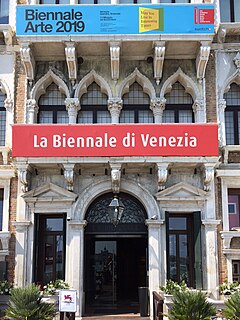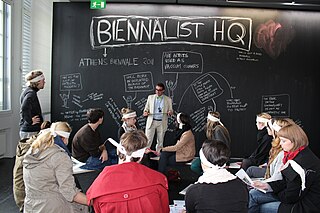Related Research Articles

The Venice Biennale is an arts organization based in Venice and the name of the original and principal biennial exhibition the organization presents. The organization changed its name to the Biennale Foundation in 2009, while the exhibition is now called the Art Biennale to distinguish it from the organization and other exhibitions the Foundation organizes.

Hans Ulrich Obrist is a Swiss art curator, critic and historian of art. He is artistic director at the Serpentine Galleries, London. Obrist is the author of The Interview Project, an extensive ongoing project of interviews. He is also co-editor of the Cahiers d'Art review.

Basak Senova is an art curator, writer and designer from Istanbul, Turkey. She lives and works in Vienna since 2017.

Stefano Cagol is an Italian contemporary artist living in Italy, Germany and Norway. He works with video, photography and installation and performance art.

Thierry Geoffroy, also known as Colonel, is a Danish-French artist, living in Copenhagen, Denmark. He is a Conceptual artist using a wide variety of media including video and installations, often collaborative with other artists.

Alterazioni Video is an artist collective founded in 2004 in Milan, Italy and is now based in New York and Berlin. The members of the group are Paololuca Barbieri Marchi, Alberto Caffarelli, Matteo Erenbourg, Andrea Masu and Giacomo Porfiri.
Massimiliano Gioni is an Italian curator and contemporary art critic based in New York City, and artistic director at the New Museum. He is the Artistic Director of the Nicola Trussardi Foundation in Milan. Gioni was the curator of the 55th Venice Biennale.
Wooloo is a Danish artist collective founded by Sixten Kai Nielsen, Russell Ratshin and Martin Rosengaard.
Paula Nascimento is an Angolan architect and curator who along with Stefano Rabolli Pansera curated the Angolan pavilion at the 55th International Art Exhibition - La Biennale di Venezia which won the Golden Lion for "best national participation".
Khaled Ramadan consultant, curator, filmmaker educator, and cultural writer. Currently, he is working as an examiner for the higher artistic educational programmes under The Danish Ministry of Higher Education and Science and as an evaluator of Alto University professorship program. He is the co-editor of the new book, Journalism in Times of War, by Al Jazeera Media Institute, (2018) Aljazeera TV Doha. He is the new appointed director of the Media Art Research Space – MARC, Production and Exhibition Spaces of Art and Film - Antalya, open in April 2017. Previously, Ramadan has worked as director of BMAF, Muscat, a senior advisor for the Maldives Ministry of Culture and for the Danish Arts Council, and as an external consultant for the Prince Claus Fund, the Manifesta Foundation, and the Nordic Institute for Contemporary Arts (NIFCA).
The Egyptian pavilion is a national pavilion of the Venice Biennale. It houses Egypt's official representation during the Biennale. The building is part of a complex that Brenno Del Giudice designed in 1932 to house Venetian decorative arts on Sant'Elena Island—an expansion of the Biennale from its main Giardini area. The building later served as Switzerland's national pavilion before the country moved to a new pavilion in 1952 and left the building to Egypt. The national pavilions for Serbia and Venice flank the Egyptian pavilion. Egypt's 1995 exhibition won the Biennale's Golden Lion award for best national pavilion.
The French pavilion houses France's national representation during the Venice Biennale arts festivals.

The national pavilions host each participant nation's official representation during the Venice Biennale, an international art biennial exhibition held in Venice, Italy. Some countries own pavilion buildings in the Giardini della Biennale while others rent buildings throughout the city, but each country controls its own selection process and production costs.
The Belgian pavilion houses Belgium's national representation during the Venice Biennale arts festivals.
The Brazilian pavilion houses Brazil's national representation during the Venice Biennale arts festivals.
The Korean pavilion houses South Korea's national representation during the Venice Biennale arts festivals.
The Uruguayan pavilion houses Uruguay's national representation during the Venice Biennale arts festivals.
The Serbian pavilion houses Serbia's national representation during the Venice Biennale arts festivals.

The Israeli pavilion houses Israel's national representation during the Venice Biennale arts festivals.
The Nordic pavilion houses the national representation of the Nordic countries Sweden, Norway, and Finland during the Venice Biennale arts festivals.
References
Books
- 55. Esposizione Internazionale d'Arte – la Biennale di Venezia. Il palazzo enciclopedico, Marsilio Editori, 2013 ISBN 978-88-317-1558-4
- Portable Nation. Maldives Pavilion, edited by Dorian Batycka, Camilla Boemio, Alfredo Cramerotti, Aida Eltoire, Maretti Editore, 2013 ISBN 978-88-89477-519
- Stefano Cagol, The Ice Monolith. Platform, 2013 ISBN 978-88-902879-6-1
- Klaus Schafler, Hacking the Future and Planet…, Folio Verlag, 2013 ISBN 978-3-85256-611-5
Reviews
- Holly Howe, "How this year's Venice Biennale made us think about climate change," FAD, 2013
- Claudia Jolles "Editorial" + Cover, Kunstbulletin, July-Aug, 2013
- Mariella Rossi, "Nuestro mundo es finite. Our world is finite," Lapiz, #279, 2013
- Georgina Adam, "New economies shake up the art world at Venice Biennale," BBC, June 11, 2013
- Michela Moro, "Speciale Biennale," Cool Tour. Rai 5, June 1, 2013
- Artan Krasniqi, "Bienalja si enciklopedi e hapur e artit," Koha, June 1, 2013
- Kathleen Massara, "Venice Biennale 2013 Photo Diary," Huffingtonpost, May 29, 31, 2013
- Holland Cotter, "Snapshots from Venice," The New York Times, May 29, 2013
- Melissa Pearce, "The Portable Nation. The Republic of Maldives at 55th Venice Biennale," The Culture Trip, May, 2013
- Kate Deimling, "Island Nations Seize the Venice Biennale Spotlight to Decry Climate Change," Blouin Artinfo, Apr 24, 2013
- Francesca Di Giorgio, Camilla Boemio, Alfredo Cramerotti "Le Maldive a Venezia. Cronaca di un debutto" in 'Espoarte.net' [Italian] Aug 1, 2013
Notes
- ↑ 55. Esposizione Internazionale d'Arte – la Biennale di Venezia. Il palazzo enciclopedico, Marsilio Editori, ISBN 978-88-317-1558-4
- ↑ http://maldivespavilion.com/blog/press-release-2/
- ↑ http://maldivespavilion.com/blog/curatorial-statement/
- ↑ http://maldivespavilion.com/blog/background/
- ↑ Kate Deimling, "Island Nations Seize the Venice Biennale Spotlight to Decry Climate Change," Blouin Artinfo, April 24
- ↑ Klaus Schafler, Hacking the Future and Planet…, Folio Verlag, ISBN 978-3-85256-611-5
- ↑ Portable Nation. Maldives Pavilion, edited by Dorian Batycka, Camilla Boemio, Alfredo Cramerotti, Aida Eltoire, Maretti Editore, ISBN 978-88-89477-519
- ↑ http://maldivespavilion.com/blog/call-for-participants-joan-of-art/
- ↑ Stefano Cagol, The Ice Monolith. Platform, ISBN 978-88-902879-6-1
- ↑ Claudia Jolles "Editorial" + Cover, Kunstbulletin, July–August
- ↑ https://www.mqw.at/en/institutions/q21/artists-in-residence/2016/khaled-ramadan/
- ↑ http://maldivespavilion.com/blog/wp-content/uploads/2013/05/PressRelease_May22.pdf
- ↑ http://maldivespavilion.com/blog/press-release-2/
- ↑ http://maldivespavilion.com/blog/joan-of-art-program/